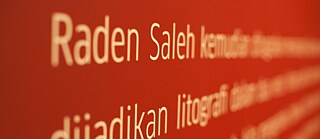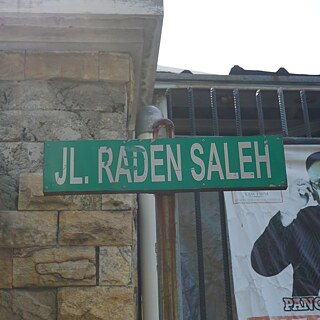Goethe Facts
The two-story building in the Cikini area and a glass installation on Jl. Sam Ratulangi witnessed Goethe-Institut Indonesien’s journey in opening up space for local people to learn more about Germany through language, culture and education. This section presents interesting facts and stories that have been seldom exposed in the 60 years since Goethe-Institut Indonesien was founded.

The sculpture Transparente Linie” was unveiled on 24 September 2002, and I am pleased that now 20 years later it has become an indispensable part of the site and continues to stand before visitors and their playful gazes.
Transparente Linie
In the summer of 2001,
the director of the institute at that time, Dr. Peter Bumke, asked me whether I would be interested in developing a sculpture for this special place after the recent relocation of the institute to its new address here. Since I had had a good working relationship with Dr. Bumke in India and was particularly interested in site-specific works, I found the project very tempting. A lively exchange of ideas and photos by e-mail ensued.It quickly became clear that the inner courtyard is often very hot during the day and the public stays mainly in the covered all-around walkway with a view of the interior space. The sculpture should therefore radiate a certain coolness, act against the energy congestion in the courtyard, convey lightness and transparency, and reveal interesting perspectives from all angles and sides. This is how the idea came about that glass with a kind of transparent free spatial drawing might be best suited for this purpose.
I received an invitation to Jakarta for Christmas 2001 to explore the environment, visit the site, and examine the architectural conditions. This was followed by taking stock of the fundamental structure of the courtyard and deciding on its central axis as the creative focus.
The Design
The sculpture is a glass stele open to four sides and sandblasted with a transparent spatial drawing. The layout of the sculpture refers directly to the site, namely two intersecting diagonals, the arrangement and angles of which represent the center of the courtyard. The sculpture, however, was moved out of the center and placed in the front area of the courtyard. It has a total height of 3.6 meters.
A stainless steel support in the center of the sculpture stabilizes the work and at the same time defines the center of the opening glass layers as a design element. The diagonally intersecting, sandblasted glass surfaces are embellished with transparent lines that point beyond the boundaries of the material and thus expand the viewer’s perception into different directions of the space. Viewer movement, different light and weather moods render diverse constellations of the sculptural form and lines.
The Artwork Stands
In the first half of 2002 in Munich, I created a 1:10 scale model and tried out various line constellations while also clarifying costs and technical details with a glass company, metalworking shop, and stress analysts.
In summer of 2002 I found out that no public “art-on-building” funds would be available for this federal property. Dr. Bumke succeeded in securing sponsorship from Siemens.
This meant that the foundations could be built on site, the night-time lighting could be organized, and the sculpture parts could be transported by air. The extremely difficult erection of the heavy sculpture with a local architectural office and construction team turned into an artistic performance of its own, thanks to the workers there, who worked entirely with their hands.
Munich, April 2022
Dorothea Frigo
Jl. Raden Saleh Raya
A building in the Cikini district of Jakarta
once bore witness to ongoing German language learning within its walls. Between 1997 and 2000, the Goethe-Institut Jakarta annexed the former East German Embassy building on Jl. Raden Saleh Raya to accommodate more language course participants.The five classrooms available at the Goethe-Institut Jakarta on Jl. Matraman Raya 23 were not sufficient to meet the great demand for German courses in 1997. The decision to use the building on Jl. Raden Saleh Raya allowed the Goethe-Institut Jakarta to conduct German language courses in two locations at once.
The additional two-story building held about ten classrooms. Its interior resembled a labyrinth due to its winding corridors and many doors. The property had once been home to the Herder Institute, an East German state institution that also offered German lessons in its time.
The use of both places as centres for learning German prompted the Goethe-Institut to offer additional classes on Saturdays and Sundays. This decision was well received by prospective course participants, so much so that the classes on both Jl. Matraman Raya and Jl. Raden Saleh Raya were full of students every day. However, the twenty to thirty German teachers at that time had to be willing to go between two locations for their teaching work.
Jakarta, May 2022
Ryan Rinaldy


